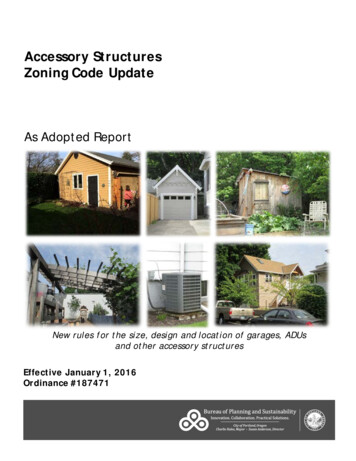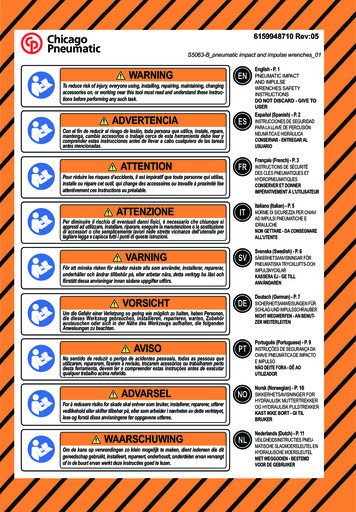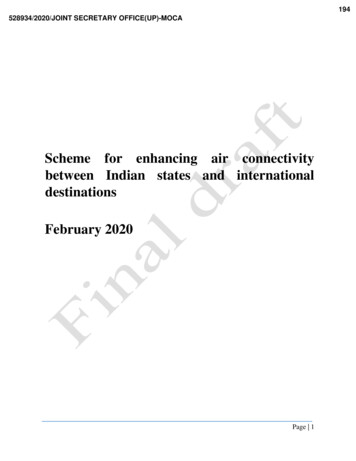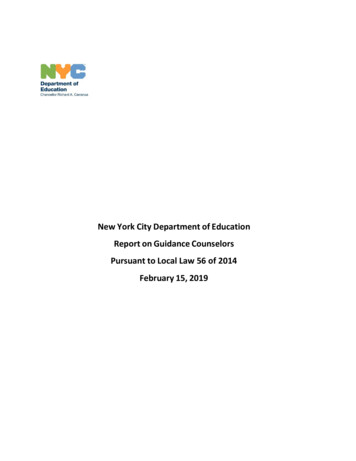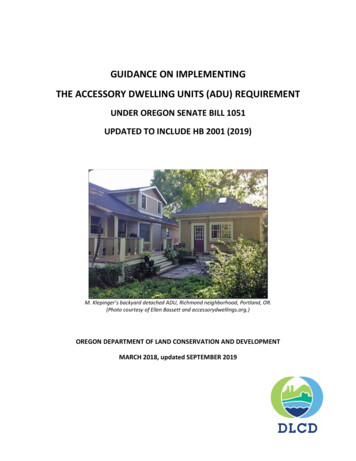
Transcription
GUIDANCE ON IMPLEMENTINGTHE ACCESSORY DWELLING UNITS (ADU) REQUIREMENTUNDER OREGON SENATE BILL 1051UPDATED TO INCLUDE HB 2001 (2019)M. Klepinger’s backyard detached ADU, Richmond neighborhood, Portland, OR.(Photo courtesy of Ellen Bassett and accessorydwellings.org.)OREGON DEPARTMENT OF LAND CONSERVATION AND DEVELOPMENTMARCH 2018, updated SEPTEMBER 2019
IntroductionAs housing prices in Oregon go up, outpacing employment and wagegrowth, the availability of affordable housing is decreasing in citiesthroughout the state. While Oregon’s population continues to expand,the supply of housing, already impacted by less building during therecession, has not kept up. To address the lack of housing supply,House Speaker Tina Kotek introduced House Bill (HB) 2007 during the2017 legislative session to, as she stated, “remove barriers todevelopment.” Through the legislative process, legislators placed muchof the content of HB 2007 into Senate Bill (SB) 1051, which thenpassed, and was signed into law by Governor Brown on August 15,2017 (codified in amendments to Oregon Revised Statute 197.312). Inaddition, a scrivener’s error1 was corrected through the passage of HB4031 in 2018.Among the provisions of SB 1051 and HB 4031 is the requirementthat cities and counties of a certain population allow accessorydwelling units (ADUs) as described below:a) A city with a population greater than 2,500 or a county with apopulation greater than 15,000 shall allow in areas within theurban growth boundary that are zoned for detached single‐family dwellings the development of at least one accessorydwelling unit for each detached single‐family dwelling, subjectto reasonable local regulations relating to siting and design.b) As used in this subsection, “accessory dwelling unit” means aninterior, attached or detached residential structure that is usedin connection with or that is accessory to a single‐familydwelling.This requirement became effective on July 1, 2018 and subject citiesand counties must now accept applications for ADUs inside urbangrowth boundaries (UGBs).On August 8, 2019, Governor Brown signed HB 2001, whichestablished that off‐street parking and owner‐occupancyrequirements are not “reasonable local regulations relating to sitingand design.” This means that, even if a local development coderequires off‐street parking and owner‐occupancy, as of January 1,2020, local jurisdictions may not mandate off‐street parking spacesfor ADUs nor require a property owner to live in either a primary or1The scrivener’s error in SB 1051 removed the words “within the urban growth boundary.” HB 4031 added the words intostatute and thus limited the siting of ADUs to within UGBs. As a result, land within a city with a population greater than2,500 but that is not within a UGB is not required by this law to be zoned to allow accessory dwelling units. For countieswith a population greater than 15,000, only those unincorporated areas within a UGB are required by this law to bezoned to allow accessory dwelling units.ADU Guidance‐2‐September 2019
accessory dwelling. The law provides an exception for ADUs that areused as vacation rentals, which may be mandated to provide off‐street parking or have owner‐occupancy requirements.Some local governments in Oregon already have ADU regulationsthat meet the requirements of SB 1051 and HB 2001, however,many do not. Still others have regulations that, given the overalllegislative direction to encourage the construction of ADUs to meetthe housing needs of Oregon’s cities, are not “reasonable.” TheOregon Department of Land Conservation and Development (DLCD)is issuing this guidance and model code language to help localgovernments comply with the legislation. The model code languageis included at the end of this document.Guidance by TopicThe purpose of the following guidance is to help cities and countiesimplement the ADU requirement in a manner that meets the letter and spiritof the law: to create more housing in Oregon by removing barriers todevelopment.Number of UnitsThe law requires subject cities and counties to allow “at least oneaccessory dwelling unit for each detached single‐family dwelling.”While local governments must allow one ADU where required,DLCD encourages them to consider allowing two units. For example,a city or county could allow one detached ADU and allow anotheras an attached or interior unit (such as a basement conversion).Because ADUs blend in well with single‐family neighborhoods,allowing two units can help increase housing supply while nothaving a significant visual impact. Vancouver, BC is a successfulexample of such an approach.Siting StandardsIn order to simplify standards and not create barriers todevelopment of ADUs, DLCD recommends applying the same or lessrestrictive development standards to ADUs as those for otheraccessory buildings. Typically that would mean that an ADU could bedeveloped on any legal lot or parcel as long as it met the requiredsetbacks and lot coverage limits; local governments should notmandate a minimum lot size for ADUs. So that lot coveragerequirements do not preclude ADUs from being built on smaller lots,local governments should review their lot coverage standards tomake sure they don’t create a barrier to development. Additionally,some jurisdictions allow greater lot coverage for two ADUs. Toaddress storm water concerns, consider limits to impermeablesurfaces rather than simply coverage by structures.Any legal nonconforming structure (such as a house or outbuildingADU Guidance‐3‐September 2019
that doesn’t meet current setback requirements) should be allowedto contain, or be converted to, an ADU as long as the developmentdoes not increase the nonconformity and it meets building and firecode.Design StandardsAny design standards required of ADUs must be clear and objective(ORS 197.307[4]). Clear and objective standards do not containwords like “compatible” or “character.” With the exception of ADUsthat are in historic districts and must follow the historic districtregulations, DLCD does not recommend any special design standardsfor ADUs. Requirements that ADUs match the materials, roof pitch,windows, etc. of the primary dwelling can create additional barriersto development and sometimes backfire if the design and materialsof the proposed ADU would have been of superior quality to thoseof the primary dwelling, had they been allowed. Other standards,such as those that regulate where entrances can be located orrequire porches and covered entrances, can impose logistical andfinancial barriers to ADU construction.Public UtilitiesDevelopment codes that require ADUs to have separate sewer andwater connections create barriers to building ADUs. In some cases,a property owner may want to provide separate connections, butin other cases doing so may be prohibitively expensive.System Development Charges (SDCs)Local governments should consider revising their SDC ordinances tomatch the true impact of ADUs in order to remove barriers to theirdevelopment. In fact, HB 2001, passed by the Oregon Legislature in2019, requires local governments to consider ways to increase theaffordability of middle housing types through ordinances andpolicies, including waiving or deferring system developmentcharges. ADUs are not a middle housing type, but if a localgovernment is reviewing its SDCs for middle housing, that would bea good time to review ADU SDCs as well. ADUs are generally able tohouse fewer people than average single‐family dwellings, so theirfiscal impact would be expected to be less than a single‐familydwelling. Accordingly, it makes sense that they should be chargedlower SDCs than primary detached single‐family dwellings. WaivingSDCs for ADUs has been used by some jurisdictions to stimulate theproduction of more housing units.ADU Guidance‐4‐September 2019
This page intentionally left blank.ADU Guidance‐5‐September 2019
Accessory Dwellings (model code)Note: ORS 197.312 requires that at least one accessory dwelling be allowed per detached single-family dwelling inevery zone within an urban growth boundary that allows detached single-family dwellings. The statute does notallow local jurisdictions to include off-street parking nor owner-occupancy requirements. Accessory dwellings arean economical way to provide additional housing choices, particularly in communities with high land prices or alack of investment in affordable housing. They provide an opportunity to increase housing supply in developedneighborhoods and can blend in well with single-family detached dwellings. Requirements that accessory dwellingshave separate connections to and pay system development charges for water and sewer services can pose barriersto development. Concerns about neighborhood compatibility and other factors should be considered andbalanced against the need to address Oregon’s housing shortage by removing barriers to development.The model development code language below provides recommended language for accessory dwellings. Theitalicized sections in brackets indicate options to be selected or suggested numerical standards that communitiescan adjust to meet their needs. Local housing providers should be consulted when drafting standards for accessorydwellings, and the following standards should be tailored to fit the needs of your community.Accessory dwellings, where allowed, are subject to review and approval through a Type I procedure[,pursuant to Section,] and shall conform to all of the following standards:[A. One Unit. A maximum of one Accessory Dwelling is allowed per legal single-family dwelling. The unit maybe a detached building, in a portion of a detached accessory building (e.g., above a garage or workshop), ora unit attached or interior to the primary dwelling (e.g., an addition or the conversion of an existing floor)./A. Two Units. A maximum of two Accessory Dwellings are allowed per legal single-family dwelling. One unitmust be a detached Accessory Dwelling, or in a portion of a detached accessory building (e.g., above agarage or workshop), and one unit must be attached or interior to the primary dwelling (e.g., an addition orthe conversion of an existing floor).]B. Floor Area.1. A detached Accessory Dwelling shall not exceed [800-900] square feet of floor area, or [75-85]percent of the primary dwelling’s floor area, whichever is smaller.2. An attached or interior Accessory Dwelling shall not exceed [800-900] square feet of floor area,or [75-85] percent of the primary dwelling’s floor area, whichever is smaller. However,Accessory Dwellings that result from the conversion of a level or floor (e.g., basement, attic, orsecond story) of the primary dwelling may occupy the entire level or floor, even if the floor areaof the Accessory Dwelling would be more than [800-900] square feet.C. Other Development Standards. Accessory Dwellings shall meet all other developmentstandards (e.g., height, setbacks, lot coverage, etc.) for buildings in the zoning district, except that:1. Conversion of an existing legal non-conforming structure to an Accessory Dwelling is allowed,provided that the conversion does not increase the non-conformity;ADU Guidance‐6‐September 2019
2. No off-street parking is required for an Accessory Dwelling;3. Properties with two Accessory Dwellings are allowed [10-20%] greater lot coverage than thatallowed by the zone in which they are located; and4. Accessory dwellings are not included in density calculations.Definition (This should be included in the “definitions” section of the zoning ordinance. It matches thedefinition for Accessory Dwelling found in ORS 197.312)Accessory Dwelling – An interior, attached, or detached residential structure that is used inconnection with, or that is accessory to, a single-family dwelling.ADU Guidance‐7‐September 2019
UNDER OREGON SENATE BILL 1051 UPDATED TO INCLUDE HB 2001 (2019) M. Klepinger's backyard detached ADU, Richmond neighborhood, Portland, OR. (Photo courtesy of Ellen Bassett and accessorydwellings.org.) OREGON DEPARTMENT OF LAND CONSERVATION AND DEVELOPMENT MARCH 2018, updated SEPTEMBER 2019


